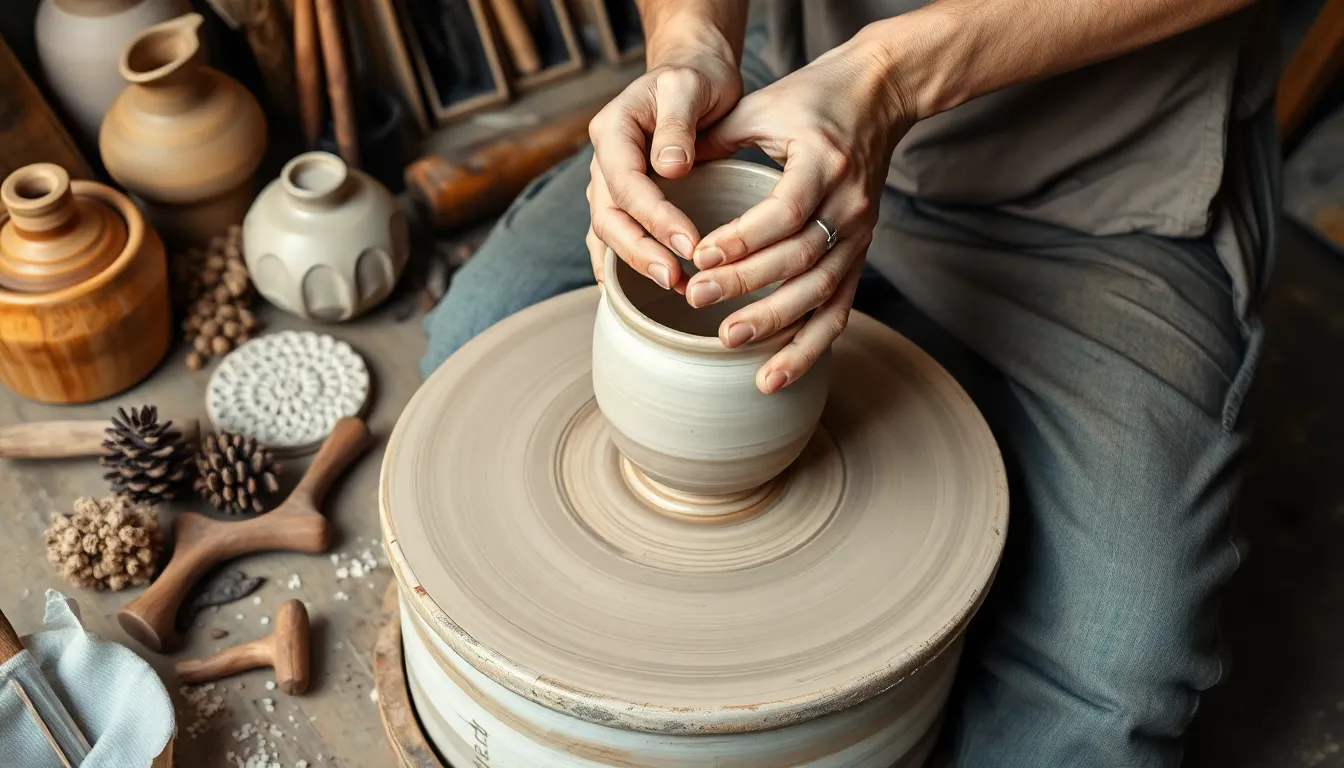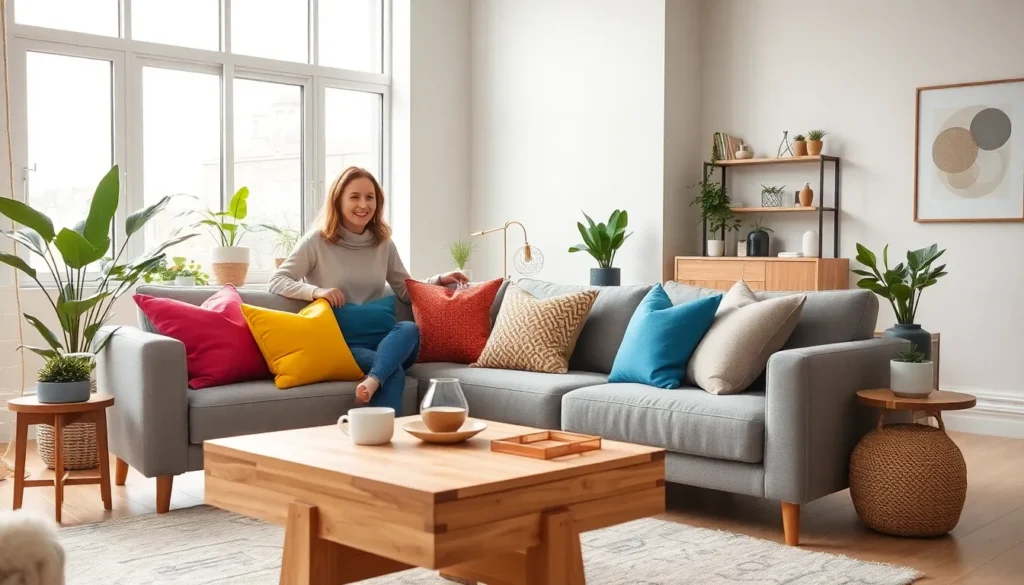In a world flooded with mass-produced items, artisan design concepts stand out like a unicorn at a horse race. These unique creations blend craftsmanship with creativity, offering a refreshing alternative to cookie-cutter designs. Imagine sipping your morning coffee from a mug that tells a story or lounging on a chair that feels like a warm hug—artisans bring these dreams to life.
Table of Contents
ToggleOverview of Artisan Design Concepts
Artisan design concepts prioritize individuality and creativity over mass production. These designs often showcase skilled craftsmanship, resulting in unique products that stand out in any environment. Each piece represents a narrative, infusing personality and emotion into functional items.
Crafting by hand, artisans employ traditional methods honed over years, reflecting their dedication to quality. The materials used often include sustainable options, aligning with contemporary values for eco-friendliness. Examples range from hand-thrown pottery to custom furniture, emphasizing uniqueness and functionality.
Unique finishes and textures define artisan objects, enhancing aesthetic appeal and tactile experience. Shoppers frequently choose these products for their personal stories and the connection to the maker. Each interaction invites appreciation for the artistry involved in creation, making every purchase more meaningful.
Community support plays a crucial role in the popularity of artisan designs. Local markets and online platforms consistently highlight artisans, connecting them directly with consumers. This direct relationship fosters transparency and trust, as customers often know the story behind each item.
Artisan design also includes collaborations among artists across various disciplines, resulting in innovative products that challenge conventional aesthetics. These partnerships foster a blend of styles and expand artistic boundaries. While mass-produced items lack character, artisan designs offer a refreshing alternative infused with culture and history.
Overall, the appeal of artisan design concepts lies in their authenticity and distinctiveness, catering to those who seek individuality in their living spaces.
Key Characteristics of Artisan Design

Artisan design encapsulates creativity and craftsmanship. Key features define this unique approach.
Craftsmanship
Craftsmanship stands as the foundation of artisan design. Skilled artisans dedicate time and focus to each piece, showcasing expertise that sets them apart from mass production. Attention to detail ensures that every item possesses a distinct character. Techniques such as hand-throwing ceramics, hand-weaving textiles, or custom woodwork result in creations filled with emotion and history. Each crafted piece carries a story, inviting consumers to connect on a personal level. Artisans often incorporate traditional methods, celebrating cultural heritage while pushing contemporary boundaries. Individual expression thrives in each work, emphasizing the skill that breathes life into ordinary objects.
Material Selection
Material selection plays a crucial role in defining artisan design. Sustainable, locally-sourced materials resonate with eco-conscious consumers. Artisans prefer natural substances, highlighting the unique qualities of items from diverse regions. Choices often include organic textiles, reclaimed wood, or recycled metals, reflecting a commitment to environmental responsibility. Each material’s inherent characteristics influence the final design, creating an authentic aesthetic. Finishes vary from raw textures to polished surfaces, enhancing visual appeal while maintaining functionality. Artisans prioritize quality over quantity, ensuring that selections contribute both to the product’s story and its longevity.
Popular Artisan Design Styles
Artisan design styles reflect unique aesthetics that resonate deeply with individual tastes. Each style emphasizes craftsmanship, creativity, and a personal touch.
Rustic
Rustic design embodies warmth and simplicity, often featuring natural materials. Wood, stone, and metal play significant roles in creating an inviting atmosphere. Handcrafted furniture, like reclaimed wood tables, showcases the beauty of imperfections, contributing to the overall charm. Textiles, too, emphasize earthy tones and organic patterns, enhancing the cozy feel. This style evokes a deep connection to nature, often reminding individuals of rural settings. Rustic design often integrates vintage elements, adding history to contemporary spaces. Artisans utilizing sustainable wood and other local materials promote an eco-friendly ethos, appealing to conscientious consumers.
Contemporary
Contemporary design focuses on clean lines and minimalistic approaches, reflecting modern sensibilities. It blends comfort and functionality, prioritizing open spaces filled with light. Artisans create bespoke furniture with simple forms, emphasizing both aesthetics and usability. Unique finishes, such as polished metals or handcrafted textiles, enhance the sleekness while adding character. This style often embraces bold colors and geometric patterns, providing striking visual contrasts. Flexible spaces that facilitate social interactions appeal to many individuals. Contemporary artisan creations are not merely decorative; they tell stories of innovation and craftsmanship. Each piece reflects a commitment to quality, ensuring longevity in both design and function.
The Role of Sustainability in Artisan Design
Sustainability plays a crucial role in artisan design, guiding material choices and production methods. Artisans prioritize eco-friendly practices by using sustainable and locally sourced materials, which appeal to the growing market of eco-conscious consumers. Often, this approach reduces waste while supporting local economies and promoting environmental responsibility.
Handcrafted items made from natural materials exemplify this commitment. For example, artisans frequently create pottery from locally sourced clay or furniture from reclaimed wood. Each piece not only reflects craftsmanship but also emphasizes a connection to the local environment and community.
Additionally, artisans focus on low-impact techniques to minimize their carbon footprint. By producing items in small batches rather than mass-producing, artisans limit excess inventory and reduce energy consumption. Each creation embodies a personal touch, showcasing both artistry and sustainability.
Collaboration among artisans further enhances sustainable practices. Partnerships often involve sharing resources and ideas, leading to innovative products that prioritize eco-friendliness. This collaborative spirit supports a community ethos, fostering transparency and trust in artisan markets.
As consumer awareness of environmental issues grows, the demand for sustainable artisan products increases. These designs provide an alternative to mass-produced items, encouraging buyers to choose quality over quantity. By investing in artisan creations, consumers contribute to a more sustainable future and preserve traditional craftsmanship.
Overall, the integration of sustainability into artisan design strengthens the appeal of unique, handcrafted products. Artisans advocate for responsible practices while delivering aesthetic and functional value, making their designs not only beautiful but also meaningful.
How to Incorporate Artisan Design into Your Space
Incorporating artisan design elevates any space significantly. Start by selecting unique pieces like handcrafted furniture or handmade pottery. Such items provide character, distinguishing one’s home from mass-produced interiors.
Layering textures enhances warmth and visual appeal. Utilize items made from natural materials, such as reclaimed wood and natural fibers, for a rustic yet sophisticated atmosphere. Consider also opting for artisan textiles, like handwoven throws or pillows, that add comfort and style.
Mix and match different styles to create a personalized aesthetic. Combining rustic elements with contemporary designs fosters an inviting and dynamic living space. Strive for balance by choosing a few standout pieces to serve as focal points while surrounding them with complementary decor items.
Support local artisans and access curated collections through local markets or artisan shops. Building connections with creators ensures authenticity and backstory for each piece. Emphasizing transparency fosters a deeper appreciation for the craftsmanship involved.
Curate a collection of artisanal accessories that reflect individual taste. Handmade ceramics, intricate wall art, or custom lighting fixtures can transform ordinary spaces into extraordinary environments. Each piece contributes to the overall story one wishes to tell through their design.
Adopt a mindful approach to color and shape. Artisan designs often feature organic shapes and earthy tones that resonate with the natural world. Incorporating these elements fosters a feeling of harmony within a room.
Challenge convention by exploring bold patterns or unique forms. Artisan design invites experimentation, making it possible to express personal style confidently. Unleash creativity by weaving artisan pieces throughout one’s home, transforming spaces into reflections of individuality and craftsmanship.
Artisan design concepts offer a refreshing escape from the uniformity of mass production. By emphasizing individuality and craftsmanship, these unique creations breathe life into everyday items. Each piece not only serves a purpose but also tells a story, allowing consumers to connect on a personal level.
The commitment to sustainability further enhances the appeal of artisan products. By prioritizing eco-friendly practices and locally sourced materials, artisans contribute to a more responsible approach to consumption. This resonates deeply with today’s eco-conscious buyers.
Incorporating artisan design into personal spaces transforms homes into reflections of personal style. By choosing handcrafted items and supporting local artisans, individuals celebrate creativity and craftsmanship while making meaningful choices. Embracing these concepts fosters a deeper appreciation for artistry and adds character to any environment.









